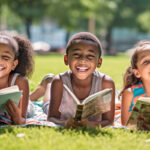Reading is a powerful tool for developing children’s cognitive and emotional skills. Children’s literature is a unique and powerful way to introduce them to valuable life skills and moral lessons. In this article, we will introduce you to the best classic books for kids to read. These books have stood the test of time and have won the hearts of generations of children.

Why Classic Books are Important for Children
Classic books are significant for children in numerous ways. They help to build a strong foundation in literature, encourage imagination and creativity, and teach timeless lessons and values. Let’s explore these benefits in more detail:
Building a Strong Foundation in Literature
Exposing children to classic literature helps them develop a love for reading, and helps build a strong foundation in literature. Classic books are well written, often contain complex plots and characters, and use language differently from modern books. Children’s literature is an opportunity for children to experience different writing styles which can help them develop critical thinking skills and broaden their vocabulary. It also allows them to analyze and appreciate the writing styles of different authors.
For example, reading books like “To Kill a Mockingbird” by Harper Lee or “The Catcher in the Rye” by J.D. Salinger can help children understand complex themes such as social injustice, growing up, and identity. These books are not only entertaining but also provide a learning experience that can help children develop empathy and understanding towards others.
Encouraging Imagination and Creativity
Reading classic books encourages children to use their imaginations and enhances their creativity. These books often take readers on magical and imaginative journeys, introducing them to fantastical characters and worlds. By delving into the pages of these stories, children can explore, dream and create. By being exposed to different creative ideas, children can develop critical thinking skills that will help them understand the world around them.
For instance, books like “Alice’s Adventures in Wonderland” by Lewis Carroll or “The Chronicles of Narnia” by C.S. Lewis, take children on magical and imaginative journeys that inspire creativity and imagination. These books allow children to explore different worlds and characters, and imagine themselves as part of the story. This type of imaginative play helps children develop problem-solving skills, creativity, and the ability to think outside the box.
Timeless Lessons and Values
Classic books contain timeless lessons and values that have stood the test of time. Often, these books are written around life-changing events and the emotions that accompany them. They offer teachable moments and provide a platform for parents and children to discuss moral and ethical issues. Through these discussions, children gain a deeper understanding of the world around them, and of different people and cultures.
Books like “Little Women” by Louisa May Alcott or “The Adventures of Tom Sawyer” by Mark Twain, teach children important life lessons such as the value of hard work, the importance of family and friends, and the consequences of actions. These books can help children develop a strong sense of morality and ethics, and help them understand right from wrong.
In conclusion, classic books are an essential part of a child’s literary journey. They help build a strong foundation in literature, encourage imagination and creativity, and teach timeless lessons and values. By exposing children to classic literature, parents and educators can help children develop critical thinking skills, creativity, and a deeper understanding of the world around them.
The Benefits of Reading to Your Child
Reading to your child comes with an array of benefits beyond intellectual and cognitive development. It also provides a way to strengthen the parent-child bond, boost language and cognitive skills, and foster a lifelong love of reading.
Strengthening the Parent-Child Bond
Reading to your child is an excellent way to bond. Snuggling up with a good book creates a warm and cozy environment, instilling positive feelings and emotions. This activity helps foster communication channels between parents and children, and offers an opportunity to discuss issues that may be challenging to bring up in everyday conversation.
For example, reading books about emotions and feelings can help children understand and express their own emotions better. It can also help them empathize with others and develop their social skills, which is essential for their overall well-being. Moreover, reading together creates a shared experience that strengthens the relationship between parent and child, and can be a cherished memory for years to come.
Boosting Language and Cognitive Skills
Reading helps amplify language and cognitive skills in children. When children are read to, they are exposed to new words and sentence structures that they may not hear in their everyday conversations. This exposure helps build their vocabulary and comprehension skills, which are essential for academic and social success.
Reading books with complex plotlines, varied characters, and unfamiliar words challenges children to use their minds and imaginations. By doing this, children learn how to analyze and use critical thinking skills, and also learn to express themselves more fluently and effectively. In addition, reading can help improve memory and concentration skills, which can benefit children in all areas of their lives.
Fostering a Lifelong Love of Reading
Reading promotes a lifelong love of books in children. Introducing children to classic literature expands their knowledge of the world and exposes them to the many possibilities reading offers. Through reading, children can explore different cultures, times, and places. They can also learn about different professions, hobbies, and interests that they may not have been exposed to otherwise.
Furthermore, reading can be a source of comfort and entertainment for children throughout their lives. It can help them relax and unwind, and also provide an escape from the stresses of everyday life. This lifelong love of reading provides a rich source of personal enjoyment, and it’s also beneficial to their study skills and academics. Children who read regularly tend to perform better in school and have a greater chance of success later in life.
In conclusion, reading to your child is not only a fun and enjoyable activity, but it also comes with a multitude of benefits. From strengthening the parent-child bond to boosting language and cognitive skills, and fostering a lifelong love of reading, there are countless reasons to pick up a book and read to your child today!
Top 5 Classic Books for Younger Kids
Children under age five tend to enjoy stories with simple, bright illustrations and repetitive rhyming. The following are our top five recommendations:
“The Very Hungry Caterpillar” by Eric Carle
First published in 1969, “The Very Hungry Caterpillar” is a popular choice amongst parents who want to introduce their children to books early on. This classic story follows a caterpillar’s transformation into a beautiful butterfly and teaches children about numbers, days of the week, and healthy eating habits.
“Where the Wild Things Are” by Maurice Sendak
“Where the Wild Things Are” is a beloved classic tale of mischievous and rambunctious Max who travels to the land of Wild Things. Sent to his bedroom without dinner, Max creates a magical world for himself in a forest inhabited by wild things. By the time he returns home, he has learned the lesson that things always come back around, and that he is loved unconditionally.
“The Tale of Peter Rabbit” by Beatrix Potter
The iconic “The Tale of Peter Rabbit” was first published in 1902. It is a picture book that teaches children the value of being responsible and the importance of staying safe. The book follows the adventurous Peter rabbit as he explores a garden fraught with dangers. The book teaches the joys of young, unfettered exploration in the company of like-minded friends while being mindful of danger.
“Winnie-the-Pooh” by A.A. Milne
The ever-popular tales of Winnie-the-Pooh were first published in 1926. The book chronicles the adventures of Pooh bear, Christopher Robin, and their other friends in the Hundred Acre Wood. The stories offer valuable lessons about friendship and cooperation and emphasize the importance of imagination and creativity.
“Goodnight Moon” by Margaret Wise Brown
Published in 1947, “Goodnight Moon” is a classic choice for bedtime with a simple storyline and clear illustrations by Clement Hurd. The story is about a bunny’s bedtime routine, which creates a soothing, calm atmosphere for younger children.
Top 5 Classic Books for Older Kids
Children over five enjoy books with more complex themes, captivating plots and lots of action. The following are our top five recommendations:
“Charlotte’s Web” by E.B. White
“Charlotte’s Web” follows the story of Charlotte, a spider who befriends a young pig named Wilbur, and their journey to save Wilbur from slaughter. The book teaches children about friendship, loyalty and sacrifice. The story also introduces them to the idea of cycles of birth, life, and death and how humans affect nature.
“The Lion, the Witch, and the Wardrobe” by C.S. Lewis
“The Lion, the Witch and the Wardrobe” is the first in the series known as “The Chronicles of Narnia.” An imaginative tale about adventure in a magical land, he book teaches children about the magic of good over evil and the true value of friendship. The story highlights important moral themes about power, forgiveness, and perspective.
“Anne of Green Gables” by L.M. Montgomery
“Anne of Green Gables” is a coming-of-age story about a young orphan girl adopted by a family who lives on Prince Edward Island in Canada. The story teaches children about the importance of positivity, kindness, and forgiveness. It also highlights the value of education and determination in fighting for what you want.
“The Secret Garden” by Frances Hodgson Burnett
“The Secret Garden” follows the story of Mary Lennox, a young girl who finds a secret garden and the joys of friendship and gardening. The book teaches children about the power of nature, the importance of community, and the transformational effect of putting others’ needs before your own.
“Little Women” by Louisa May Alcott
“Little Women” follows the coming of age story of four sisters, Meg, Jo, Beth, and Amy. Each sister has a unique personality, but together, they learn and grow together. The book teaches children about family, love, acceptance, and sacrifice.
Conclusion
Reading is an essential aspect of childhood development. Classic books help build strong foundations in literature, encourage imagination and creativity, and teach timeless lessons and values. By reading to your child, you can boost their cognitive and language skills, strengthen the parent-child bond, and foster a lifelong love of reading. Our list of the top classic books for kids to read can be an excellent starting point for parents looking to expose their children to classic literature. We hope that this article inspires a love of reading and provides cherished memories for years to come.
- The 11 Best Books About Cats You Should Read - January 16, 2024
- The 9 Best Books on Building Confidence - January 16, 2024
- Discover the 10 Best Books on the Brain - January 16, 2024


